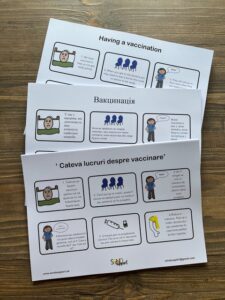Making the topic of immunisations fun with play and Makaton
This Makaton awareness day, we hear from Lydia Lings, qualified Makaton tutor and Director of SEND Support, about a project she worked on with South East London ICS to encourage uptake of childhood immunisations.
For those of us with children, we have probably all faced the dread of having to vaccinate our children and that tug of war between causing them pain now (although minimal) and knowing it will do them good in the long term. Over a year ago family wellbeing charity, The Big Red Bus Club and SEND Support, an organisation that helps parents, carers and professionals support children with special educational needs and disabilities, worked together to make vaccinations more accessible and less scary by using a few unique methods including play and sign language! And some of the outcomes were extraordinary!
Play is a fantastic medium for children to learn new skills, explore the world around them and to process feelings about particular events or experiences. So, we went about setting up a doctors’ play area in our children’s centre, with play doctor equipment including syringes. The children loved this play area and many a child had a ‘pretend’ vaccination. It was here that they acted out the experience of going to the doctors and were able to make sense of it.

 Makaton Sign language was a massive part of this project. The Makaton Charity states that “Makaton is a unique language programme that uses symbols, signs and speech to enable people to communicate”. It is very visual and allows children to process information differently, and it is also quite fun to do. We had Makaton symbols up in the doctors’ area, which gave a great visual explanation for different parts of the doctors’ surgery. We also offered free Makaton Taster sessions to parents, where they could explore using Makaton to really explain how vaccinations worked to their children.
Makaton Sign language was a massive part of this project. The Makaton Charity states that “Makaton is a unique language programme that uses symbols, signs and speech to enable people to communicate”. It is very visual and allows children to process information differently, and it is also quite fun to do. We had Makaton symbols up in the doctors’ area, which gave a great visual explanation for different parts of the doctors’ surgery. We also offered free Makaton Taster sessions to parents, where they could explore using Makaton to really explain how vaccinations worked to their children.
We then combined play, Makaton and story telling to really encourage children to be more relaxed about the topic of vaccines. Mainly using the story of ‘Zog’ by Julia Donaldson. Zog gets helped by Princess Pearl who longs to be a doctor. We had great fun telling the story along with the signs we had learnt and then re-enacting the story with our small world play area.
Children do so much better with experiences that are different or scary when they know exactly what is happening. So the next thing we created was a picture timetable explaining what happens when you go for a vaccination. We were also able to get these translated into Romanian and Ukrainian as these were predominant languages spoken in our children’s centre.
 One of the success stories of the vaccination project was with one family who had, had an awful experience with their previous vaccinations. It was so bad they were considering not having any more. However, in our sessions, they really appreciated the picture timetable that they could talk through as a family. The whole family knew what would happen and when it would happen. They also had the space to be able to speak freely about their concerns and coming along to the story sessions and having learning signs, just meant there was a fun element to something that had caused upset in the past. The day came for the vaccination appointment, and it went really smoothly and there was also chocolate shared straight after.
One of the success stories of the vaccination project was with one family who had, had an awful experience with their previous vaccinations. It was so bad they were considering not having any more. However, in our sessions, they really appreciated the picture timetable that they could talk through as a family. The whole family knew what would happen and when it would happen. They also had the space to be able to speak freely about their concerns and coming along to the story sessions and having learning signs, just meant there was a fun element to something that had caused upset in the past. The day came for the vaccination appointment, and it went really smoothly and there was also chocolate shared straight after.
Using these various techniques might seem a strange route to take when dealing with something like vaccinations but using visuals like the timetable and sign language, can really help children to process this experience in a more accessible way – and it’s enjoyable too!
